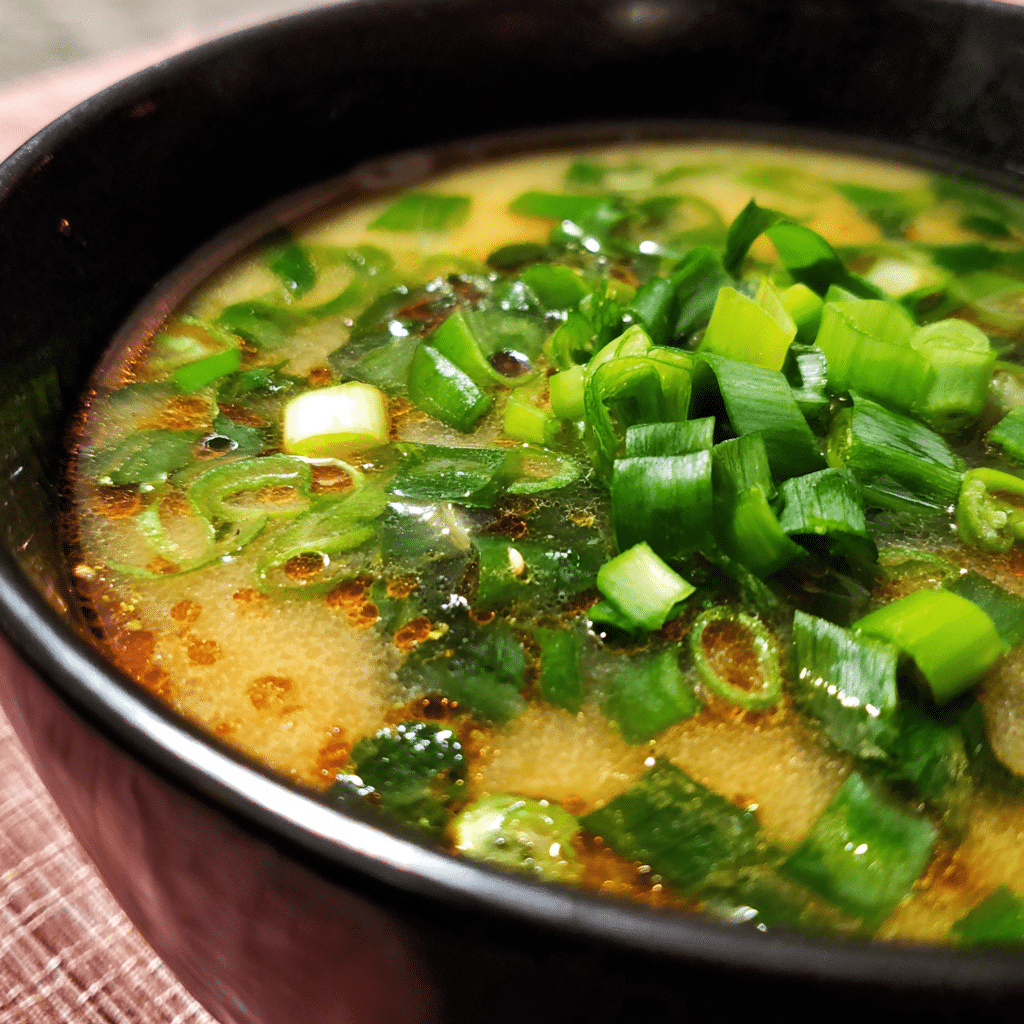Why Homemade Miso Soup Warms Your Soul

Discover the comfort of Homemade Miso Soup—simple, nourishing, and perfect for warming your soul with every delicious spoonful. This timeless Japanese classic brings together a beautiful balance of savory miso, delicate dashi broth, and fresh ingredients that instantly make you feel cozy and satisfied. Whether it’s a chilly evening or you crave some wholesome nourishment, making miso soup from scratch is easier than you think and infinitely more rewarding than any instant packet. Let’s dive in and celebrate this soul-soothing dish that feels like a warm hug in a bowl.
Why You’ll Love This Recipe
- Wholesome Comfort: Each sip brings a soothing warmth that melts away stress and fatigue.
- Simple Ingredients: Uses easy-to-find, natural ingredients you probably already have or can quickly grab.
- Quick to Prepare: Ready in under 30 minutes, perfect for weekday meals or spontaneous cravings.
- Customizable: Easily adapted with your favorite veggies, proteins, or seasonings to suit any preference.
- Nutritious Boost: Packed with probiotics, vitamins, and minerals that support digestion and overall health.
Ingredients You’ll Need
The beauty of Homemade Miso Soup lies in its simplicity and the harmony each ingredient brings. Every piece works together to create a vibrant flavor, pleasant texture, and inviting aroma.
- Miso Paste: The star ingredient, giving the soup its distinctive umami flavor and gentle saltiness.
- Dashi Stock: A light broth traditionally made from kombu and bonito flakes, providing a savory depth that’s essential.
- Tofu: Soft cubes add protein and creamy texture without overpowering the soup’s delicate taste.
- Seaweed (Wakame): Adds a subtle oceanic flavor and vibrant green color to the bowl.
- Green Onions: Fresh scallions provide a mild sharpness and color contrast for brightness.
- Water: For diluting the miso and creating the broth base.
Variations for Homemade Miso Soup
This recipe invites your creativity—adjust and personalize the miso soup to suit your diet, flavor preferences, or seasonal produce. Experiment with these easy variation ideas to keep your soup exciting every time.
- Protein Swap: Use shrimp, chicken, or eggs instead of tofu for a heartier bowl.
- Vegetable Add-ins: Incorporate mushrooms, spinach, carrots, or daikon radish for extra texture and nutrition.
- Misos Variety: Try white, red, or mixed miso pastes to change the flavor intensity and color.
- Vegan Version: Replace dashi made with bonito flakes with kombu and shiitake mushroom broth instead.
- Spicy Twist: Add a dash of chili oil or sprinkle red pepper flakes for a warming kick.

How to Make Homemade Miso Soup
Step 1: Prepare the Dashi Broth
Start by simmering kombu (dried kelp) in water for about 10 minutes without boiling, then remove it and add bonito flakes, letting them steep for a few minutes before straining. This process creates the flavorful base for your miso soup.
Step 2: Soften the Wakame and Tofu
Rehydrate dried wakame seaweed in cold water for a few minutes until it blooms into a soft, vibrant green. Cut firm tofu into small cubes, ready to gently warm in the broth later.
Step 3: Dissolve the Miso Paste
Take a ladle of hot but not boiling dashi broth and mix it with your miso paste in a separate bowl until smooth—this prevents lumps and preserves the probiotic benefits in the miso.
Step 4: Combine Ingredients and Heat Through
Add the miso mixture back into the pot with the dashi, then gently stir in tofu cubes and wakame. Warm the soup on low heat without boiling for 2-3 minutes to maintain flavor and texture.
Step 5: Finish with Fresh Green Onions
Sprinkle finely chopped green onions on top just before serving, adding freshness and a mild crunch to the bowl.
Pro Tips for Making Homemade Miso Soup
- Use high-quality miso: Fresher, authentic miso paste significantly enhances flavor complexity and health benefits.
- Don’t boil the soup: Boiling miso kills beneficial probiotics and dulls the nuanced taste.
- Adjust saltiness carefully: Miso is naturally salty, so taste before adding extra salt or soy sauce.
- Make your dashi from scratch: It’s easier than you might think and results in a richer broth than store-bought versions.
- Add ingredients last: Especially delicate items like tofu and wakame to keep their texture intact.
How to Serve Homemade Miso Soup
Garnishes
Go beyond green onions with thinly sliced mushrooms, toasted sesame seeds, or a sprinkle of shichimi togarashi for added texture and flavor highlights.
Side Dishes
Pair your miso soup with steamed rice, pickled vegetables, or a light sushi platter to balance the meal and provide satisfying variety.
Creative Ways to Present
Serve in rustic bowls with wooden spoons or trendy ceramic sets to enhance the cozy feel of your Homemade Miso Soup experience and impress guests with its elegant simplicity.
Make Ahead and Storage
Storing Leftovers
Keep leftover miso soup in an airtight container in the refrigerator for up to 2 days. Store tofu and greens separately if possible to avoid sogginess.
Freezing
Freezing miso soup is not recommended due to texture changes in tofu and seaweed, which can become rubbery or mushy after thawing.
Reheating
Reheat gently on low heat, stirring regularly, and avoid boiling to preserve the delicate flavors and nutrients in your Homemade Miso Soup.
FAQs
Can I use instant dashi powder instead of making dashi from scratch?
Yes, instant dashi powders are a convenient alternative, though freshly made dashi offers a richer, more authentic flavor to your miso soup.
Is miso soup gluten-free?
Most plain miso pastes are gluten-free, but always check the label to ensure no wheat or barley ingredients are included.
Can I make Homemade Miso Soup without tofu?
Absolutely! While tofu adds protein and texture, you can omit it or replace it with mushrooms or other veggies depending on your preference.
How long does Homemade Miso Soup last in the fridge?
It’s best enjoyed fresh but can be stored safely for up to 2 days in the refrigerator when kept in an airtight container.
What type of miso is best for beginners?
White miso, or shiro miso, is milder and sweeter, making it perfect for those new to miso soup.
Final Thoughts
There’s something truly magical about a bowl of Homemade Miso Soup. It’s more than just food; it’s nourishment for your body and soul that’s easy to make, endlessly adaptable, and always comforting. Invite this simple Japanese delight into your kitchen and heart—once you taste it homemade, you’ll never want to go back!
Related Posts
- Why Roasted Garlic Tomato Soup Warms Your Soul
- Why French Onion Soup Is the Ultimate Comfort Food
- Why Lemon Chicken Soup Is Perfect for Any Meal

Homemade Miso Soup
- Prep Time: 10 minutes
- Cook Time: 15 minutes
- Total Time: 25 minutes
- Yield: 4 servings 1x
- Category: Appetizers
- Method: Simmering
- Cuisine: Japanese
- Diet: Gluten Free
Description
Homemade Miso Soup is a simple, nourishing, and comforting Japanese classic that combines savory miso paste, delicate dashi broth, soft tofu, wakame seaweed, and fresh green onions. Ready in under 30 minutes, this wholesome soup is perfect for warming your soul and easily customizable to suit your taste and dietary preferences.
Ingredients
Main Ingredients
- 4 cups water (for dashi and broth base)
- 1 piece kombu (dried kelp, about 4x4 inches)
- 1 cup bonito flakes
- 3 tablespoons miso paste (white, red, or mixed)
- 1/2 cup dried wakame seaweed (rehydrated in water)
- 1/2 cup firm tofu, cut into small cubes
- 2 green onions, finely chopped
Instructions
- Prepare the Dashi Broth: Start by placing kombu into 4 cups of water and gently simmer for about 10 minutes without boiling. Remove the kombu, then add the bonito flakes and steep for 3-5 minutes before straining the broth. This creates the savory dashi base for your miso soup.
- Soften the Wakame and Tofu: Rehydrate dried wakame seaweed in cold water for a few minutes until it blooms into a soft, vibrant green. Cut firm tofu into small cubes, ready to be warmed gently in the broth later.
- Dissolve the Miso Paste: Take a ladle of hot but not boiling dashi broth and mix it with the miso paste in a separate bowl until smooth. This prevents lumps and helps preserve the probiotic benefits of the miso.
- Combine Ingredients and Heat Through: Add the miso mixture back into the pot with the dashi broth. Gently stir in the tofu cubes and rehydrated wakame. Warm the soup over low heat for 2-3 minutes without boiling to maintain delicate flavors and texture.
- Finish with Fresh Green Onions: Sprinkle finely chopped green onions on top of the soup just before serving to add freshness and a mild crunch.
Notes
- Use high-quality, fresh miso paste for better flavor and health benefits.
- Do not boil the soup after adding miso paste to preserve probiotic qualities and taste.
- Taste the soup before adding extra salt or soy sauce since miso paste is naturally salty.
- Make dashi broth from scratch for richer flavor but instant dashi powder can be used as a convenient alternative.
- Add delicate ingredients like tofu and wakame last to maintain their texture.
Nutrition
- Serving Size: 1 cup
- Calories: 60
- Sugar: 1g
- Sodium: 600mg
- Fat: 2g
- Saturated Fat: 0.3g
- Unsaturated Fat: 1.5g
- Trans Fat: 0g
- Carbohydrates: 6g
- Fiber: 1g
- Protein: 5g
- Cholesterol: 0mg
Keywords: miso soup, homemade miso soup, Japanese soup, tofu soup, dashi broth, comfort food, gluten free, vegetarian option, probiotic soup






